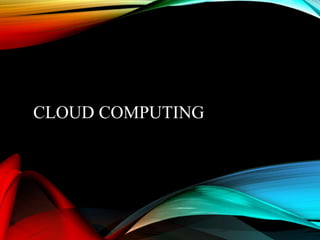
cloud computing
- 2. INTRODUCTION Cloud computing is the practice of using a network of remote servers hosted on the Internet to store, manage, and process data. Traditional business applications have always been very complicated and expensive. Many industries and organizations have turned towards cloud computing by 2013, cloud computing has already become a highly demanded service and lately the cloud service providers are experiencing a growth rate of 50% per annum.
- 3. ARCHITECTURE
- 4. ARCHITECTURAL CONSTRAINTS Transparency- It is important that your CSP provides complete transparency regarding the security they use and have in place to protect your companies’ sensitive information. Scalability- This encompasses the ability to expand with additional infrastructure resources, applications can scale up to prevent the lack of resources from hindering performance or they can also scale down the infrastructure statically to support a new smaller environment. Security- It is the set of control-based technologies and policies designed to adhere to regulatory compliance rules and protect information, data applications and infrastructure associated with cloud computing use.
- 5. TYPES OF CLOUD Public Cloud- It is a cloud computing model, in which a service provider makes resources, such as virtual machines (VMs), applications or storage, available to the public over the internet. Private Cloud- It is a type of cloud computing that delivers similar advantages to public cloud, including scalability and self-service, but through a proprietary architecture. Community Cloud- It is a cloud service model that provides a cloud computing solution to a limited number of individuals or organizations that managed by all the participating organizations. Hybrid Cloud- It is a cloud computing environment which uses a mix of private cloud and public cloud services with orchestration between the two platforms.
- 7. SERVICE MODELS SaaS(Software as a Service)- It is a software distribution model in which a third-party provider hosts applications and makes them available to customers over the Internet. Eg: google apps, microsoft office 365 ( PaaS(Platform as a Service)- It is a category of cloud computing that provides a platform and environment to allow developers to build applications and services over the internet. Eg: Windows Azure Cloud services. ( IaaS(Infrastructure as a Service)- It is an instant computing infrastructure, provisioned and managed over the Internet. Quickly scale up and down with demand and pay only for what you use. Eg: Amazon EC2, Azure platform services. (
- 8. APPLICATIONS Disaster recovery Backup File storage Test and development
- 9. DISADVANTAGES Downtime Security Issues Cost Data Transfer Costs
- 10. CONCLUSION Cloud computing has emerged as better way of computing by providing a range of advantages and applications. It is being adopted and practiced by many companies to escape the burden of managing and storing their data. Despite its many advantages, it has a few setbacks. However, cloud computing is advancing at a fast pace and will continue to excel among the user community.
- 11. THANK YOU..! - Likhitha T L D Madhurima K